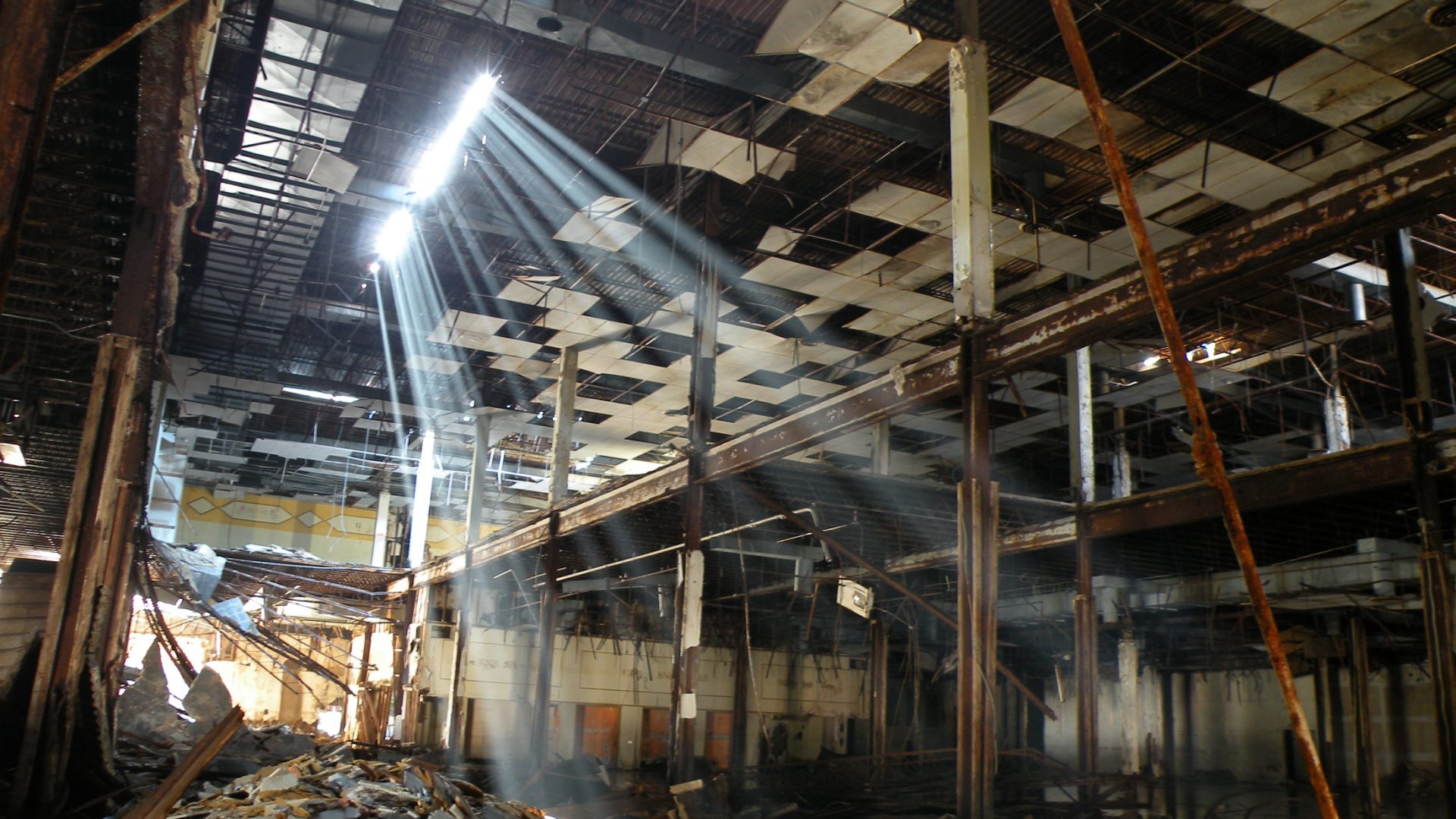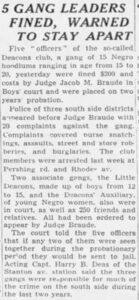| Founded | Founded in or near Douglas |
|---|---|
| Founding story | Founded at Oakland/Douglas Ida B. Wells projects |
| Affiliations | Give details |
| Colors | Yellow and Purple |
| Primary ethnicities | African American |
| Symbols | Give details |
| Status | Extinct |
The story of the Deacons begins in January 1941 along the Oakland and Douglas neighborhood border. This is exactly when the Ida B. Wells public housing projects were completed and the first families from the area were moving into these projects that were built on the former site of the Aldine Square town homes that were blighted townhouses that were formerly luxury town homes for the wealthy until they moved away during the first African American migration wave of 1915. These townhomes fell into disrepair and the families that lived in them were victims of slumlords that took advantage of the growing black community in the neighborhood. Ida B. Wells was the first project in Chicago for African Americans and was often viewed as luxury living for the surrounding community that was no privileged to enough to move into these projects. Ida B. Wells once sat between 37th Street to Pershing and from Cottage Grove to Martin Luther King Drive.
According to The Explosion of Chicago’s Black Street Gangs: 1900 to Present by JUseni Eugene Perkins , there are two theories on the origins of the Deacons. One theory if that they formed as soon as Ida B. Wells was built to protect the community area from jealousy from other gangs in the neighborhood. The other is that the gang existed before the projects were built and used the projects as a way to expand their numbers. The evidence of the second theory was shown in the book when Howell said the leader was never a resident of the projects. I agree with both theories and believe they are both completely relevant. I can’t say exactly how far back in time the Deacons go back but they may have operated in Aldine Square originally until it was razed in the late 30s for Ida B. Wells. I can say that if the Deacons formed prior to Ida B. Wells it would have taken place in the later 1930s because according to a July 27, 1945 Chicago Tribune article, the Deacons were aged 15-20; therefore, the oldest guys would have been around 16 when the group was brought to the projects (Source: Chicago Tribune July 27, 1945). I believe that the leader did not rub his hands together like an evil warlord waiting for these projects to be built just to recruit, I believe the Deacons wanted to reclaim the area and bonded with youths moving into the projects and complaining about outside groups hanging out in their park (Madden Park) that had a pool, gymnasium and a playground while bullying the Ida B. Wells kids because of their “privilege.” When Ida B. Wells was opened, most families were dual income and a father figure was in the household, not only that, these families were not far below the poverty line which led many to consider these people “privileged.” Gangs like 13 Cats and Destroyers were giving these youths a hard time and the more mature Deacons stepped in with something like an agreement with the people of Ida B. Wells where they would exchanged using the projects as their turf in exchange for protecting the territory while recruiting. This is my take on it and a blend of these two theories that coincides with how most historic Chicago gangs operated (Source: The Explosion of Chicago’s Black Street Gangs: 1900 to Present, Useni Eugene Perkins).
Deacons also fought racial battles against white youths that were still in the majority in the Oakland community. Whites heavily protested the projects during construction and even succeeded in creating some construction delays. All African American gangs in the Bronzeville area fought white gangs from 1919 until the 1950s when the focus was more shifted on fighting other African American gangs. The Deacons were the first Chicago gang to have a structure of female members (Deaconettes) and young members (Little Deacons). The Deacons were one of the first street gangs in Chicago to branch out to different neighborhoods. According to The History of Street Gangs in the United States: Their Origins and Transformations, by James C. Howell, the female group of Deacons known as “Deaconettes” fought with the female counterpart of the Italian Nobles gang. I am not sure if the Italian Nobles are the same as the Taylor Street Nobles, an Italian gang; if this is referring to the Taylor Nobles they were on the Near West Side neighborhood of Chicago which far from Bronzeville. I had seen a picture of old Deacon Graffiti once that was captioned to be on the west side, so perhaps the Deacons made their way to the Near West Side. I really wish I saved the image and caption because I saw it over 20 years ago on the internet. The Deacons did spread throughout Bronzeville in the Oakland, Douglas and Grand Boulevard areas by the 1950s. Deacons were also know to commit crimes like “purse snatchings, assaults, street and store robberies and burglaries,” according to the July 27, 1945 Tribune article. At the time of the article the police had known about theses crimes since 1943.
The Deacons acted as the alpha gang in the area and even organized gang fights at 37th and Vernon in a park. The Deacons even arranged what type of weapons would be used in the fight, if any. The Deacons main African American gang enemies were the Destroyers and the 13 Cats.
The Deacons were not dope dealers nor were they really even killers, they were fighters, warriors and leaders among the youths but they were gangsters in a way that wore colors and painted graffiti on the walls.
The 1950s was the peak time for the Deacons and they swelled to over 1,000 members in Bronzeville and the west side. The early 1960s would mark the beginning of the end for the Deacons as a more violent breed of gangs began fighting the Deacons at the borders of Bronzeville. Gangs like Black Stone Rangers and Devil’s Disciples were a part of a new breed of gangs that were willing to kill rivals to gain territory; some members of the Deacons began flipping to Disciples or Rangers.
In the mid-1960s the Deacons began losing territory and more numbers in the Bronzeville area as Rangers and Disciples became larger organizations than the Deacons.
On the west side Vice Lords were taking apart any Deacons that spread there, now the Deacons were weakened significantly and more members were flipping to Rangers, Supreme Gangsters or Disciples.
By the late 1960s the last of the Deacons were taken apart because they did not fit in with the new breed of violent killers and dope dealers that made up the newer street gangs like Black P Stones, Vice Lords, Black Disciples and Gangsters. The last of the young Deacons all flipped to Stones, Disciples and Gangsters and the Ida B Wells fell under Stone and Disciple control.
What we can take away from the Deacons is that they are likely the original blue print for later gangs like Gangster Disciples, Black P Stones and Vice Lords to model after. The Deacon structure and branching was unique at the time and perhaps ahead of its time making the Deacons the founders of organized gangs and branching out.
Please send in 1940s, 1950s and 1960s pics!

